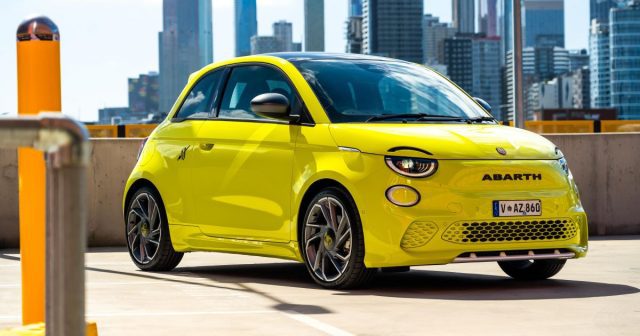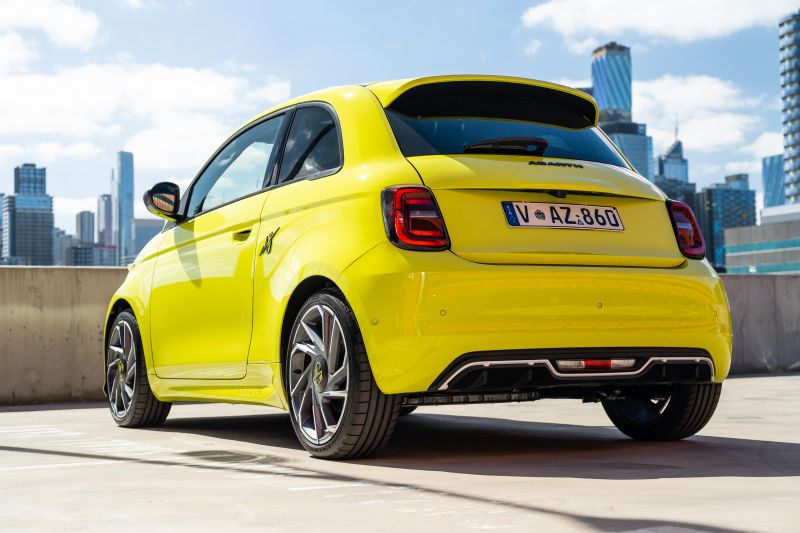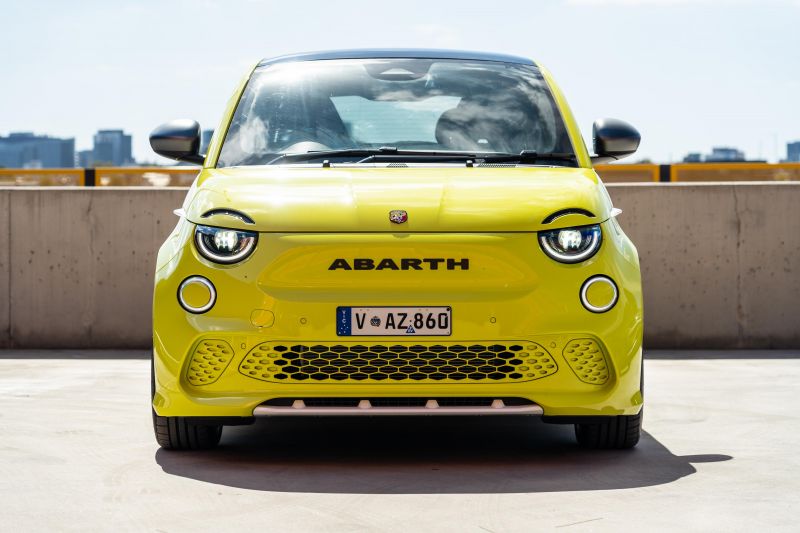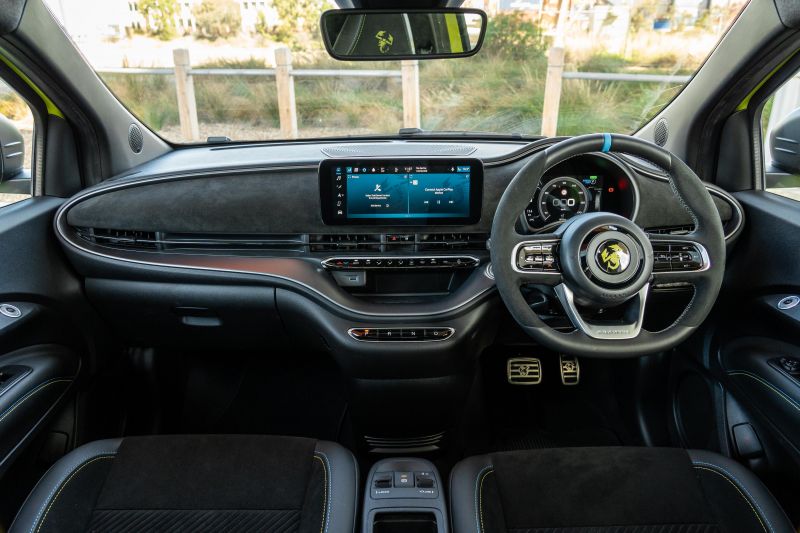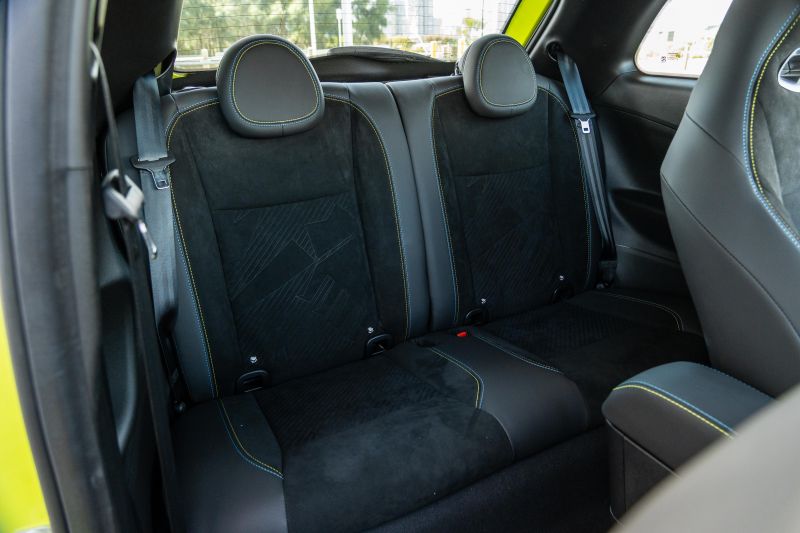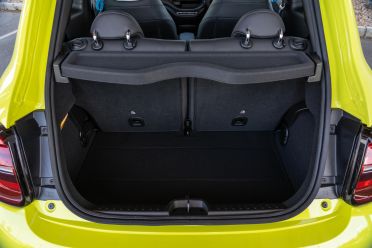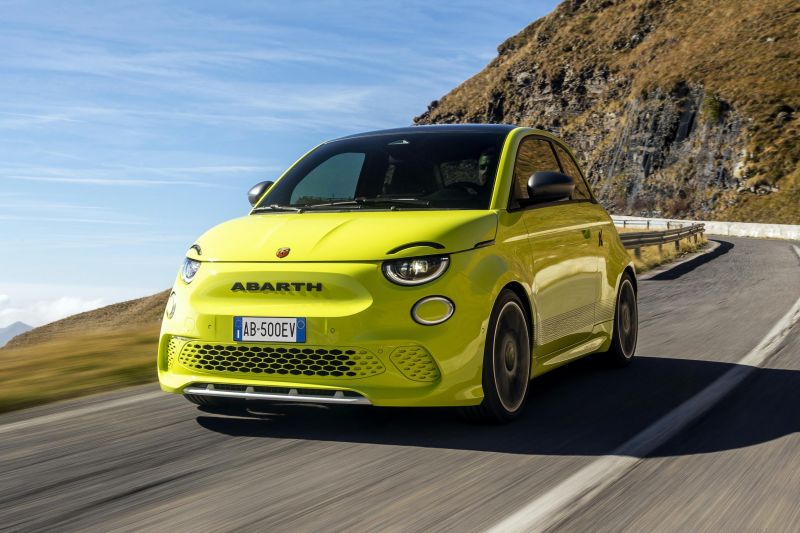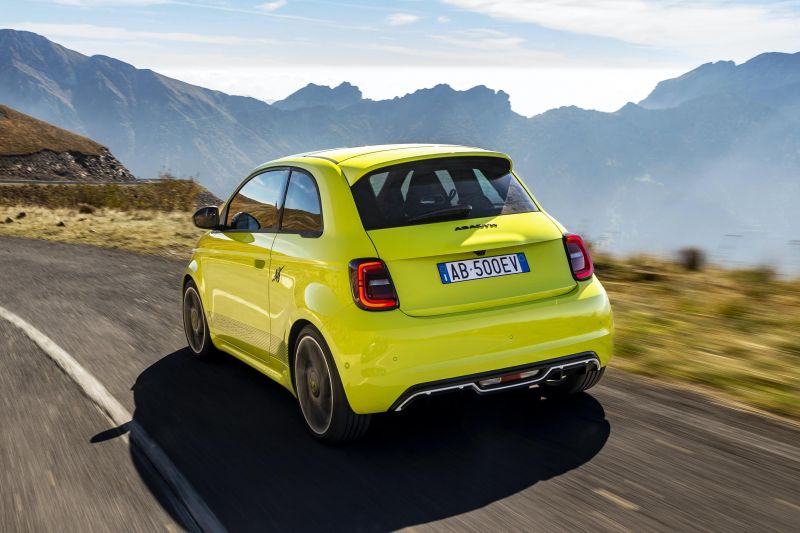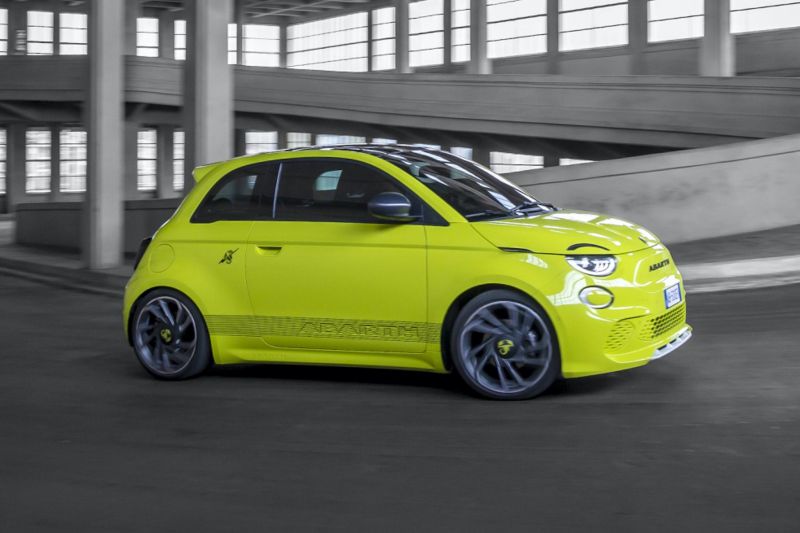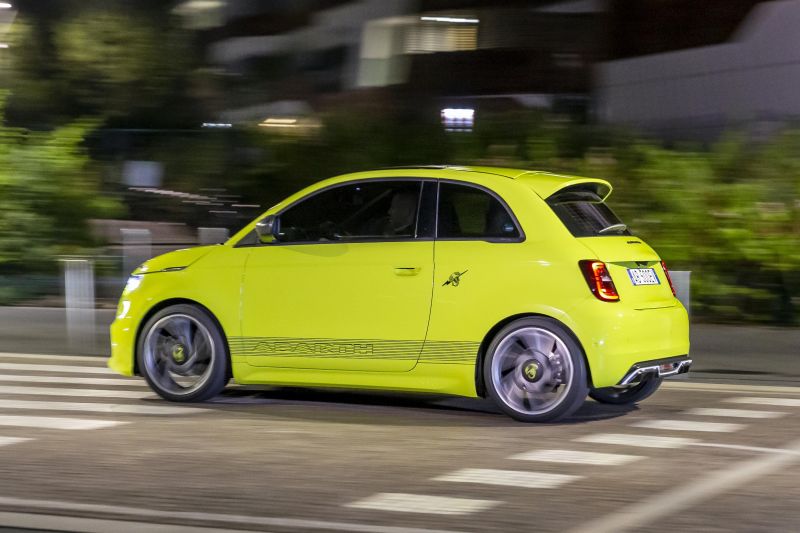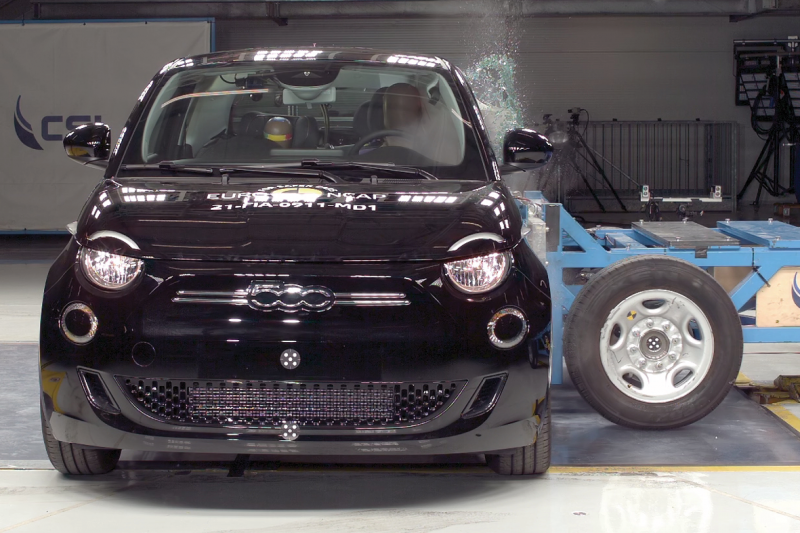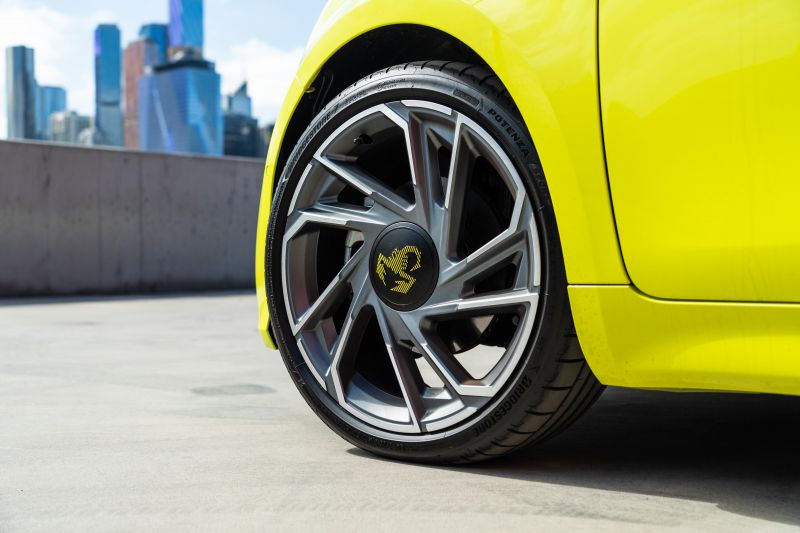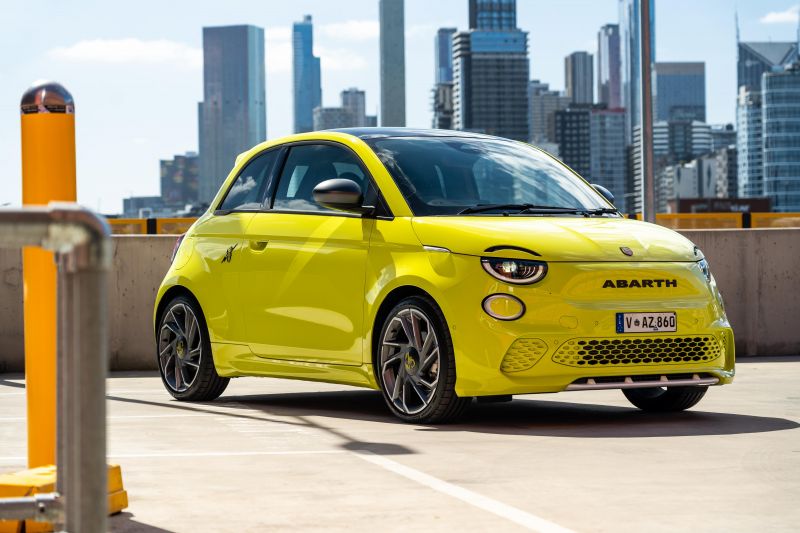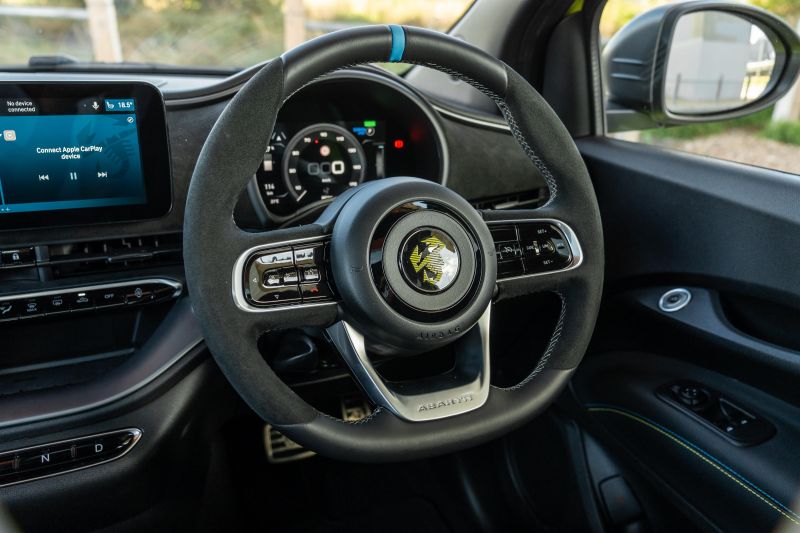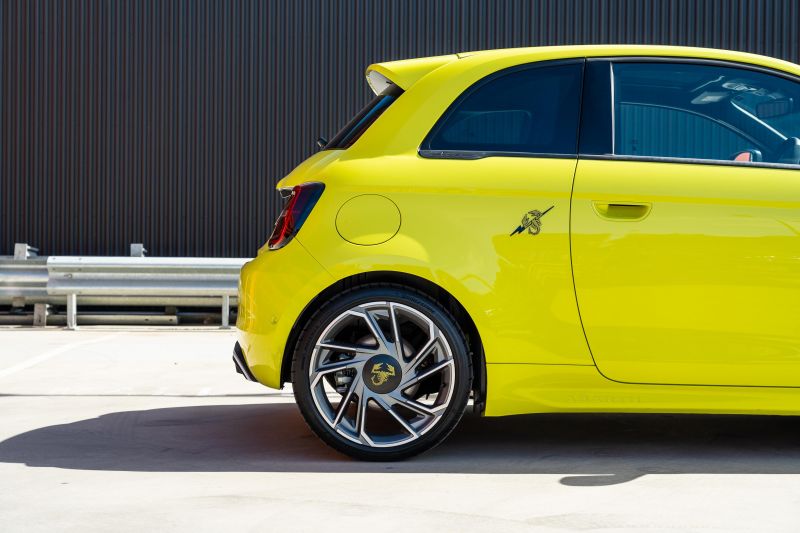The people’s performance car of Italy has gone electric.
No, it’s not a Ferrari or Lamborghini, it’s an Abarth – itself an extension of the hugely popular Fiat 500 family.
The 2024 Abarth 500e is an electrifying take on the proven Abarth formula, taking the Fiat 500, giving it more power and more focused running gear, and making it make a lot of noise.
Noise in an EV? Yes, Abarth’s engineers have spent thousands of hours working on a system called Exhaust 2.0, which plays engine sounds inside and outside the car based on recordings of the Abarth 595/695’s Record Monza exhaust.
If that’s not in your face enough, our test car’s Acid Green exterior paint surely has to be. It’s somewhere between rolling tennis ball and highlighter, and no doubt will be cause for people to stop and stare on the street.
Can this satisfy the Italian hot hatch diehards?
How does the Abarth 500e compare?
View a detailed breakdown of the Abarth 500e against similarly sized vehicles.

Abarth
500e
How much does the Abarth 500e cost?
On test we have the ‘regular’ 2024 Abarth 500e Turismo – priced from $58,900 plus on-road costs. There’s also limited stock of the Scorpionissima launch edition remaining, which is limited to 219 units nationally.
2024 Abarth 500e pricing:
- 2024 Abarth 500e Turismo: $58,900
- 2024 Abarth 500e Scorpionissima: $60,500
Prices exclude on-road costs
To see how the Abarth 500e lines up against its rivals, check out our comparison tool.
What is the Abarth 500e like on the inside?
Abarth has basically taken the Fiat 500e’s interior and suede-ified it.
The overall design and layout of the cabin is all familiar from the Fiat version, but there’s various Abarth Scorpion badging and highlights everywhere as well as Acid Green and Poison Blue highlights throughout.
Ahead of the driver is a rejigged version of the Fiat 500e’s 7.0-inch TFT cluster, which gets Abarth-specific graphics and offers a number of layouts to suit your tastes.
I kept the central speedo and tacho dial up for my time with the car, and the theme and changes depending on drive mode, progressively getting brighter and more aggressive as you cycle through Turismo, Scorpion Street and Scorpion Track modes.
While the additional power meter readout had more fluid animations, the speedo dial almost ticked through the various points on the rim like a clock. It’s not necessarily a positive or negative, but a general observation.
Sitting proudly atop the dash is a 10.25-inch touchscreen infotainment system running the Stellantis Uconnect 5 interface. It’s the latest and greatest software from the group, and is a marked improvement over previous Abarths.
It offers embedded navigation, DAB+ radio, as well as wireless Apple CarPlay and Android Auto – the latter working reliably with my iPhone 15 Pro Max with the exception of one occasion. The six-speaker JBL audio system goes pretty hard, though if you dial it up the windows and rearview mirror might shake a bit.
Fiat and Abarth have also included good storage space for such a little car, with a grippy wireless phone charger which also has a Torino skyline graphic. There’s also a deep centre cubby with sliding lid, decent door pockets, and a couple of cupholders.
I prefer the new “Premium Sporty Seats” over the old car’s pews, trimmed in leather and Alcantara to match the steering wheel, dashboard, and doors. There’s a Scorpion graphic on the headrests of both front seats, Acid Green double stitching, and decent levels of adjustment in both the seats and steering wheel – big tick.
As you’d expect of a light-class car, the back seat is best left for occasional use and smaller passengers. Think of it as a 2+2, if you will.
You can fit average sized adults back there for short trips if you really need, and the front seats easily fold out of the way via the bright blue straps on the seat backs.
The front passenger seat will even slide back and recline into a more accommodating position automatically after using the release function, which was handy when a taller friend sat behind a shorter friend during a short trip.
You can put child seats back there courtesy of the ISOFIX anchor and top tether points on both rear seats too.
The boot is tiny, as you’d expect – with 185L quoted with the rear seats in place. Abarth doesn’t quote a seats-down figure, but it’s definitely more accommodating as a two seater thanks to the 500e’s taller proportions.
There’s also no spare wheel, rather a “Fix and Go Tyre Repair Kit”.
What’s under the bonnet?
The Abarth 500e gets a more powerful electric motor than its Fiat equivalent, and remains front-wheel drive.
| Model | Abarth 500e |
|---|---|
| Drivetrain | Single-motor electric |
| Battery | 42kWh li-ion |
| Power | 113kW |
| Torque | 235Nm |
| Driven Wheels | Front |
| Weight | 1335kg (tare) |
| 0-100km/h (claimed) | 7.0 seconds |
| Top speed (claimed) | 150km/h |
| Energy consumption (claimed) | 18.1kWh/100km |
| Energy consumption (as tested) | 16.3kWh/100km |
| Claimed range | 253km |
| Max AC charge rate | 11kW |
| Max DC charge rate | 85kW |
| Charge time (AC) | 4 hr 15 min (11kW 0-100 per cent) |
| Charge time (DC) | 35 min (85kW 0-80 per cent) |
To see how the Abarth 500e lines up against its rivals, check out our comparison tool.
How does the Abarth 500e drive?
Starting up the electric Abarth is… interesting.
If you have the sound generator off, you’ll get a funny electric guitar sound playing when you hit the starter button to turn it on or off.
If you have the sound generator on, the guitar still plays but it’s quickly overpowered by a very prominent burble reminiscent of the combustion powered Abarth 595/695 with the Record Monza exhaust. It’s arguably louder on the outside than inside.
As you set off there’s even a sound that simulates you disengaging the clutch, but from there it lines up its fake revs to throttle inputs and speed. On the freeway there’s a pretty loud drone which for some might get tiresome, but I enjoyed the constant soundtrack because it’s just like the petrol one.
It’ll even rev if you have it at a standstill. Press the throttle in P or N and the 500e will play a revving sound and react much like the old 1.4-litre engine under the bonnet.
The outputs may seem meek on paper, but having 235Nm on tap from the moment you hit the accelerator in a pretty light (~1300kg) hatchback makes for pretty brisk progress off the line.
It pulls strongly from rest and right through to about 60 or 80km/h, tapering off a bit as you get to highway speeds. There’s better response than the petrol-powered Abarth at low speeds, but the old one pulled harder at speed.
Keep in mind the Abarth 500e is more aligned with the base-level 123kW Abarth 595 rather than the 132kW Abarth 695 we still get in Australia. Even so, Abarth’s representatives claim the 500e is 50 per cent quicker from 20-40km/h than its petrol predecessor.
Abarth’s 7.0-second claim from 0-100 feels accurate by the seat of the pants, and it feels more responsive on a roll too – the brand quotes a 20 per cent improvement in acceleration from 60-100km/h.
Worth noting are the different outputs depending on drive mode. The standard Turismo mode limits the drivetrain to 100kW/220Nm and engages maximum regen (one-pedal mode) for best efficiency; Scorpion Street gives you the full 113kW/235Nm with one-pedal driving; and Scorpion Track is max attack with no regen.
I generally cycled between Turismo and Scorpion Street in normal driving, and the extra response of the latter is notable if you really gun it. You’ll notice the trip computer will add a few kilometres to the remaining range if you switch from one of the Scorpion modes to Turismo, and there’s also a Turtle mode if you’re running really low on charge and limits top speed to 80km/h.
It doesn’t come undone at freeway speeds either, partly thanks to the 60mm wider track and 24mm longer wheelbase over the old 695. There’s a more confident stance as the speed climbs and the 500e feels more substantial.
I’d argue that while still firm, the electric Abarth rides better than its ageing predecessor, and the larger footprint means it’s a more confident handler. There are 18-inch alloys (huge on a car like this) shod in 205/40 rubber front and rear, which is pretty much the same tyre specification as the old one, bar the extra inch in wheel diameter.
The 500e corners with gusto, albeit with a top-heavy feel like its forebears. But this just adds to the fun. The heavier steering tune is responsive and accurate, and while there’s no fancy limited-slip diff or torque vectoring function you can have quite a lot of fun without things getting too lairy.
For me, there was the simple pleasure of blasting out of roundabouts, making quick overtakes on main roads, and carving up the ramps of shopping centre carparks. It feels like a big kid’s toy – if a pretty expensive one.
Driving like this means you’ll likely never achieve the advertised driving range of 253km. On delivery and after charging it our test car showed roughly 225km of range, though our real-world consumption figure of 16.3kWh/100km bettered the claim in mixed driving and would get close to the advertised range.
A major development over the old 695 is the inclusion of modern driver assistance systems, even if the Abarth misses out on some of the functionality in the cheaper Fiat version.
AEB with vulnerable road user detection is standard, as is lane-keep assist and blind-spot monitoring. These alone bring the Abarth 500 into the modern era, and align the teeny hatch with other Stellantis products.
There’s also a reversing camera with front and rear parking sensors, though the Abarth 500e lacks the Level 2 autonomous driving assist (adaptive cruise and lane centring) offered in the Fiat which would make extended highway stints that little bit more relaxing – though the 200km-ish range means extended stints wouldn’t be that extended.
I’m sure the Italians would say, however: “ma questa è un’auto da guida, perché ne hai bisogno?” Or put simply, this is a driver’s car, so Abarth owners are more likely to want to have full control.
What do you get?
Abarth 500e Turismo highlights:
- 18-inch alloy wheels
- Full LED exterior lighting
- LED headlights
- LED daytime running lights
- LED tail lights
- Automatic headlights
- Automatic high-beam
- Rain-sensing wipers
- Panoramic fixed glass roof
- Privacy glass
- Titanium grey mirror caps
- Heated exterior mirrors
- Alcantara upholstery
- Leather, Alcantara-wrapped steering wheel
- 10.25-inch touchscreen infotainment system
- Satellite navigation
- Wireless Apple CarPlay, Android Auto
- 7.0-inch digital instrument cluster
- Keyless entry, start
- Climate control
- DAB+ digital radio
- 6-speaker JBL sound system
- Heated front seats
- Height-adjustable driver seat
- Metal pedals and sill plates
- 50:50 split-fold rear seats
- USB-A and USB-C outlets
- Auto-dimming rear-view mirror
- Wireless phone charger
- Mode 3 charging cable
Abarth 500e Scorpionissima adds:
- Digital certificate of authenticity
- Abarth decals
Is the Abarth 500e safe?
The Abarth 500e is currently isn’t rated by ANCAP, though the related Fiat 500e received a four-star ANCAP rating based on testing conducted by Euro NCAP in 2021.
Standard safety equipment includes:
- 6 airbags
- AEB incl. Vulnerable Road User detection
- Blind-spot monitoring
- Driver attention monitoring
- Intelligent speed limit assist
- Lane keep assist
- Parking sensors front, side, rear
- Reversing camera
- Traffic sign recognition
- Tyre pressure monitoring
How much does the Abarth 500e cost to run?
The Abarth 500e is covered by a three-year, 150,00km new vehicle warranty, which is well behind the pack these days.
The battery is covered for eight years or 160,000km; and there’s roadside assistance thrown in for three years. Most rivals offer at least five years of support for new vehicle and roadside these days.
Abarth is offering capped price servicing at $300 per visit for up to 10 years. Intervals are 12 months or 15,000km.
CarExpert’s Take on the Abarth 500e
It’s fun, fast, but flawed – which is quintessentially Abarth, really.
Against more objective metrics like our scoring system or relative to the market, the Abarth 500e doesn’t make a whole lot of sense.
It’s very expensive, doesn’t offer a lot of range, and really is outgunned by rival EV hatches like the MG 4 XPower and Cupra Born in the performance stakes. Then there’s the lack of practicality, the in your face looks and the sub-par warranty coverage.
But that’s not really the point, is it? The old Abarth 695 suffers similar drawbacks, if not worse, and this new electric one makes huge strides in tech, safety, comfort and refinement.
What Abarth has done here is rebirth its iconic baby hot hatch for the electric age. It looks, feels and drives like an Abarth-fettled Fiat 500 should, and anyone who has enjoyed a petrol one in the past should love this.
I genuinely couldn’t wipe the smile off my face every time I saw it, let alone every stint behind the wheel. It’s so silly, in the most charming and fun way.
Real talk; if the range wasn’t so short, I would have seriously considered putting an order in.
Click the images for the full gallery
MORE: Buy an Abarth 500e
MORE: Everything Abarth 500e















